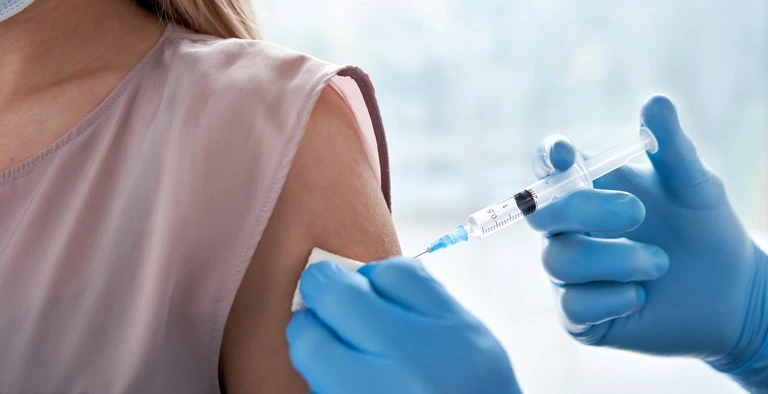
Vaccinations are one of the most effective public health interventions, saving millions of lives each year. They work by stimulating the body’s immune system to recognize and fight specific pathogens, such as viruses or bacteria, without causing the disease itself. Here’s why they are so important in public health:
1. Prevention of Disease:
Vaccines protect individuals from infectious diseases like measles, polio, influenza, and COVID-19. By preventing illness, they reduce the severity and spread of diseases, ultimately saving lives.
2. Herd Immunity:
When a significant portion of a population is vaccinated, it creates herd immunity. This means the spread of contagious diseases is slowed or stopped, protecting those who can’t be vaccinated (e.g., infants, elderly, or immunocompromised individuals).
3. Reduction of Healthcare Costs:
Preventing diseases through vaccination reduces the need for expensive treatments, hospitalizations, and long-term care, easing the burden on healthcare systems.
4. Eradication and Control of Diseases:
Vaccination campaigns have successfully eradicated smallpox and significantly reduced the prevalence of diseases like polio and measles worldwide.
5. Protection of Future Generations:
By eliminating or controlling diseases, vaccinations ensure that future generations won’t have to suffer from diseases that were once widespread and deadly.
6. Economic Benefits:
Healthier populations contribute to stronger economies by reducing absenteeism from work and school and increasing productivity.
7. Global Public Health Security:
Vaccines help in the rapid containment of outbreaks, preventing epidemics or pandemics from spreading globally.
Challenges and Considerations:
- Vaccine hesitancy due to misinformation and distrust in healthcare systems.
- Access and equity issues, particularly in low-income countries.
- Need for continuous monitoring and updating of vaccines to combat emerging variants (e.g., influenza and COVID-19).
Vaccinations are not only a personal health measure but a critical component of public health strategies worldwide. They play an indispensable role in maintaining global health security and enhancing life expectancy.
Vaccinations and Their Importance in Public Health: A Comprehensive Overview
Vaccines are a cornerstone of modern public health, offering protection against infectious diseases and promoting overall societal well-being. From the smallpox eradication to the global COVID-19 pandemic response, vaccination efforts have dramatically altered the landscape of health worldwide. Here, we dive deeper into the various aspects of vaccination, examining how vaccines work, their profound importance in public health, and the challenges and future directions for vaccine development.
1. How Vaccines Work:
At their core, vaccines are designed to mimic a disease-causing organism, training the immune system to recognize and fight that pathogen if encountered in the future. Most vaccines contain harmless pieces of the pathogen (such as proteins, inactivated viruses, or weakened bacteria) which trigger an immune response. The immune system then produces specific antibodies that “remember” how to fight the pathogen.
This process allows individuals to become immune to the disease without experiencing the illness’s harmful effects. There are various types of vaccines, including:
- Inactivated or Killed Vaccines: These vaccines contain viruses or bacteria that have been killed or inactivated. Examples include the polio vaccine.
- Live-Attenuated Vaccines: These vaccines use live pathogens that have been weakened so they can’t cause illness. Examples include the measles, mumps, and rubella (MMR) vaccine.
- Subunit, Recombinant, or Conjugate Vaccines: These use parts of the pathogen, like proteins, to stimulate the immune response. Examples include the human papillomavirus (HPV) vaccine and Haemophilus influenzae type b (Hib) vaccine.
- Messenger RNA (mRNA) Vaccines: A newer form, like the Pfizer-BioNTech and Moderna COVID-19 vaccines, uses mRNA technology to instruct cells to produce a protein that triggers an immune response.
2. Impact on Public Health:
A. Preventing the Spread of Infectious Diseases:
Vaccines are a critical tool in preventing the transmission of infectious diseases within communities. By creating immunity in individuals, vaccines break the chain of transmission of diseases, significantly reducing the number of people who can spread the infection.
For example:
- Measles: Before the introduction of the measles vaccine, the disease was common and often led to severe complications or death. Widespread vaccination has reduced the incidence of measles by over 99% in many countries, though outbreaks still occur in areas with lower vaccination rates.
- Polio: Polio was once a global epidemic, paralyzing thousands of children every year. Global vaccination efforts have brought polio to the brink of eradication, with only a few countries still reporting cases.
B. Herd Immunity:
One of the most significant benefits of widespread vaccination is the concept of herd immunity, or community immunity. When a sufficient proportion of the population is vaccinated, the spread of disease is minimized, making it less likely that susceptible individuals (e.g., infants, elderly people, and those with weakened immune systems) will contract the disease.
Herd immunity thresholds vary depending on the disease. For example, measles requires around 95% of the population to be vaccinated for effective herd immunity, while the threshold for COVID-19 is still being studied, with newer variants affecting this threshold.
C. Eradication of Diseases:
Vaccination has the potential to eradicate certain diseases entirely. Smallpox, for example, is the only disease that has been completely eradicated through vaccination. The last known case occurred in 1977, and the World Health Organization declared smallpox eradicated in 1980. Polio, too, is close to being eradicated, with just a handful of cases remaining in two countries, Afghanistan and Pakistan.
D. Control of Epidemics and Pandemics:
Vaccines are a critical tool in controlling both regional epidemics and global pandemics. The rapid development and deployment of vaccines in response to the COVID-19 pandemic demonstrated the power of vaccines in curbing widespread infections. COVID-19 vaccines reduced severe illness, hospitalization, and death, ultimately helping to control the spread of the virus and preventing healthcare systems from being overwhelmed.
3. Economic and Societal Benefits of Vaccination:
A. Healthcare Cost Reduction:
Vaccines help reduce the burden of infectious diseases on healthcare systems. By preventing diseases, vaccination lowers the number of individuals who need to be hospitalized or require long-term care. This reduction in treatment costs saves governments and individuals significant amounts of money. For example, the CDC estimates that childhood vaccinations prevent approximately 21 million hospitalizations and 732,000 deaths in the U.S. alone.
B. Boosting Productivity:
Vaccines not only save lives but also contribute to economic productivity. Healthier populations result in fewer missed days of work and school, allowing individuals to contribute to their communities and economies. This positive impact is seen in various sectors, from the workforce to education, where lower disease burdens lead to better overall outcomes.
C. Global Health Security:
Vaccination plays a critical role in ensuring global health security. The ability to rapidly deploy vaccines in the event of outbreaks prevents localized health crises from escalating into global pandemics. The availability of vaccines against diseases like Ebola, influenza, and COVID-19 helps countries manage and contain outbreaks more effectively, ultimately safeguarding global health.
4. Vaccines and Social Justice:
Vaccination also has a profound role in promoting social justice by ensuring that everyone, regardless of their socioeconomic status, has access to the same health protections. Historically, poorer communities and developing countries have had less access to vaccines, which has contributed to higher disease burdens in these populations.
- Equitable Access: Global initiatives like GAVI, the Vaccine Alliance, work to ensure that vaccines are distributed to low-income countries, helping to address disparities in health outcomes. Vaccines like the rotavirus vaccine, which prevents severe diarrhea in infants, have dramatically reduced infant mortality rates in countries with previously high rates of preventable deaths.
- Addressing Vaccine Hesitancy: There are also social justice concerns about vaccine hesitancy. Misinformation, cultural beliefs, and distrust in the healthcare system can lead individuals to refuse vaccination, resulting in outbreaks and preventable deaths. Combating these barriers through education and transparent communication is crucial in building public trust and improving vaccination uptake.
5. Challenges and Obstacles in Vaccination Efforts:
A. Vaccine Hesitancy:
Despite the proven benefits of vaccines, some people remain hesitant or outright refuse to vaccinate themselves or their children. Vaccine hesitancy is driven by misinformation, fear of side effects, distrust in healthcare systems, and political or cultural factors. Addressing these concerns requires clear, transparent communication about vaccine safety and efficacy, as well as combating misinformation through media and trusted healthcare providers.
B. Access and Equity Issues:
Access to vaccines is not always equitable. Many low-income and developing countries face challenges in obtaining vaccines due to cost, logistical difficulties, and infrastructure limitations. Efforts to address these issues, such as the COVAX initiative, aim to ensure that vaccines are accessible to all, regardless of geographic location or economic status.
C. Evolving Pathogens:
The evolution of pathogens presents a unique challenge for vaccine development. For example, influenza viruses change rapidly, which is why new flu vaccines are developed every year. Similarly, COVID-19 has shown how the virus can mutate and affect vaccine effectiveness. This means that vaccine development must be ongoing, with continuous research to adapt to new strains.
D. Vaccine Production and Distribution:
The global demand for vaccines often outstrips supply, especially during pandemics. The logistics of producing, storing, and distributing vaccines—particularly those that require cold storage—can be a significant challenge. These hurdles must be addressed to ensure that vaccines reach the people who need them most, especially in remote and underserved regions.
6. The Future of Vaccination:
The future of vaccination looks promising, with new technologies improving vaccine development. Advances in mRNA technology, like those used in the COVID-19 vaccines, hold great promise for faster, more effective vaccines against a range of diseases. Other promising areas include:
- Universal Vaccines: Research is underway to develop universal vaccines for diseases like influenza and malaria, which would offer long-lasting protection against multiple strains.
- Personalized Vaccines: Scientists are exploring the potential of personalized vaccines, tailored to an individual’s unique genetic makeup or immune system, for more effective protection against diseases.
- Oral and Nasal Vaccines: New delivery methods, such as oral or nasal vaccines, could make vaccination more convenient and increase uptake rates.



 DailyMediCure
DailyMediCure 















